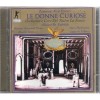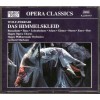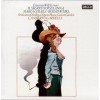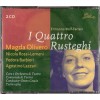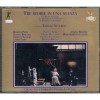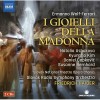| Country: | Italy |
| Period: | Neoclassicism, il Verismo |
Biography
Ermanno Wolf-Ferrari (born Ermanno Wolf) (January 12, 1876 – January 21, 1948) was an Italian composer and teacher. He is best known for his comic operas such as Il segreto di Susanna (1909). A number of his works were based on plays by Carlo Goldoni, including Le donne curiose (1903), I quatro rusteghi (1906) and Il campiello (1936).
Ermanno Wolf-Ferrari was born in Venice in 1876, the son of an Italian mother and a German father. Ferrari was his mother's maiden-name, which he added to his own surname in 1895. Although he studied piano from an early age, music was not the primary passion of his young life. As a teenager Wolf-Ferrari wanted to be a painter like his father; he studied intensively in Venice and Rome and traveled abroad to study in Munich. It was there that he decided to concentrate instead on music, taking lessons from Josef Rheinberger. He enrolled at the Munich conservatory and began taking counterpoint and composition classes. These initially casual music classes eventually completely eclipsed his art studies, and music took over Wolf-Ferrari’s life. He wrote his first works in the 1890s.
At age 19, Wolf-Ferrari left the conservatory and traveled home to Venice. There he worked as a choral conductor, married, had a son called Max Winterfeld, and met both Arrigo Boito and Verdi. Just a few years later Wolf-Ferrari debuted his first opera, Cenerentola, based on the story of Cinderella. The opera was a failure in Italy, and the humiliated young composer moved back to Munich. German audiences would prove more appreciative of his work; a revised version of Cenerentola was a hit in Bremen in 1902, while the cantata La vita nuova brought the young composer international fame.
Wolf-Ferrari now began transforming the wild and witty farces of the 18th-century Venetian playwright Carlo Goldoni into comic operas. The resulting works were musically eclectic, melodic, and utterly hilarious; every single one became an international success. In fact, until the outbreak of World War I, Wolf-Ferrari’s operas were among the most performed in the world.
In 1911 Wolf-Ferrari tried his hand at full bloodied Verismo with I gioielli della Madonna;a story of passion, sacrilege and madness. It was quite popular in its day and for a period after, especially in Chicago, where the great Polish soprano Rosa Raisa made it a celebrated vehicle. Maria Jeritza (and, later, Florence Easton) triumphed in it at the Met, in an all-out spectacular production in 1926.
World War I, however, was a nightmare for Wolf-Ferrari. The young composer, who had been dividing his time between Munich and Venice, suddenly found his two countries at war with each other. He eventually moved to safety in Zurich, but the stress and sadness of the war brought him to a complete creative standstill. It was not until after the war’s end that Wolf-Ferrari moved back to Munich and began working again. A new melancholy vein appeared in his post-war work; his operas grew darker and more emotionally complex. Among these darker operas was Sly, an opera about a comic buffoon which transforms midstream into a tale of emotional torture and suicide.
In 1900, having failed to have two previous efforts published, Wolf-Ferrari saw the first performance of one of his operas, Cenerentola, which was given in Venice. This was a failure at its premiere, although a later performance in Bremen was a success, setting a pattern for his later work, much of which was premiered in Germany and was received a good deal better there than it was in his native Italy. Among these works are Le donne curiose (1903), I quatro rusteghi (1906), and Il segreto di Susanna (1909), all of them comedies, and all of them successful at their German premieres.
In 1902 he became professor of composition and director of the Liceo Benedetto Marcello.
With the outbreak of World War I, Wolf-Ferrari moved to Zurich and composed much less, though he still wrote another comedy, Gli amanti sposi (1916). He did not really pick up his rate of output until the 1920s, when he wrote Das Himmelskleid (1925) and Sly (1927), the latter based on William Shakespeare's The Taming of the Shrew. In 1939 he became professor of composition at the Mozarteum in Salzburg. In 1946 he moved again to Zürich before returning to his home city of Venice. He died in Venice and is buried in the Venetian cemetery Island of San Michele.
As well as his operas, Wolf-Ferrari wrote a number of instrumental works, mainly at the very beginning and very end of his career. Only his violin concerto has ever been performed with anything approaching regularity, though he also wrote Idillio-concertino (essentially a chamber symphony), various pieces of chamber music including a piano quintet and two piano trio, two violin sonatas and a number of works for the organ amongst others.
Wolf-Ferrari's work is not performed very widely (with the exception of several of his overtures and his Jewels of the Madonna intermezzo) although he is generally thought of probably the finest writer of Italian comic opera of his time. His works often recall the opera buffa of the 18th century, although he also wrote more ambitious works in the manner of Pietro Mascagni, which are thought of less well. Much of his work has been ignored, although a performance in 1999 of Sly by the Washington National Opera (the work's American premiere) marked something of a revival of interest in his works.







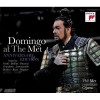
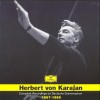
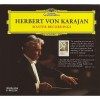
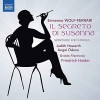
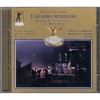
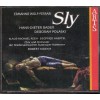
![Wolf-Ferrari - Violin Concerto op.26, Serenade for Strings [Hoelscher]](http://static.classicalm.com/repository/composition-cover/small/25680-img1445768383548213.jpg)
